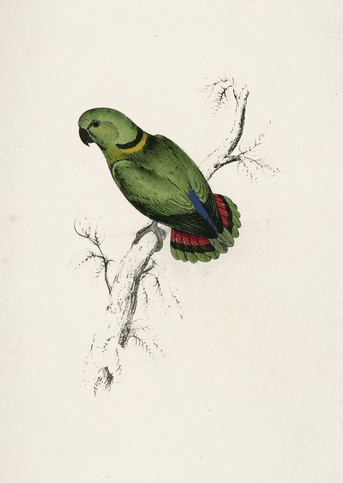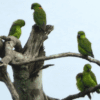Black-collared Lovebird
Also known as:
Swindern's Lovebird, Liberian Lovebird
Also known as:
Swindern's Lovebird, Liberian Lovebird
DID YOU KNOW?
The Black-collared Lovebird is an arboreal termitaria nester (it nests in termite mounds in trees.)

Agapornis

swindernianus
Size:
13 cm (5 in)
Weight:
39-40 g (1.3-1.4 oz)
Subspecies including nominate:
three: A.s. swindernianus, A.s. zenkeri, A.s. emini
Colour Adult:
A.s. swindernianus: Both adults mostly green; nuchal collar narrow and black; dull yellow neck below collar; deep lilac/blue lower back to upper tail coverts; black primary coverts; black primary and outer secondary feathers; green underwing coverts; green tail, with red lateral feathers at base and banded with black before tip. Beak grey/black. Eye yellow.
A.s. zenkeri: Both adults neck red/brown below black collar, reaching to breast as wash.
A.s. emini: Both adults as in zenkeri, but less far-reaching red/brown on neck and breast.
Colour Juvenile:
A.s. swindernianus: Black nuchal collar missing; paler blue lower back to upper tail coverts; dull orange lateral tail feathers at base. Beak pale grey with black at base. Eye brown.
A.s. zenkeri: Neck entirely green with black nuchal collar absent; otherwise as in swindernianus.
A.s. emini: As in zenkeri.
Call:
Calls are subdued and twittering. Some are rapidly repeated and shrill. Loud screeches when alarmed.
More Information:
Content Sources:
CITES
BirdLife International
Cornell Lab of Ornithology/Birds of the World
Parrots: A Guide to Parrots of the World, Juniper and Parr, 1998
Parrots of the World, Forshaw, 2006. 2010 edition
Parrots in Aviculture, Low, 1992.
Lexicon of Parrots, Thomas Arndt.
Captive Status:
Not generally found in aviculture.
Longevity:
—
Housing:
Enclosure or aviary, indoors or outdoors if in warm climate, minimum length 1.2 m (4 ft).
Diet:
Small seed mixture, containing mainly canary, millet and oats with a little hemp in cold weather; fruits such as: apple, pear, and others if taken; green leaves such as: Swiss chard, lettuce, kale, sowthistle, dandelion, chickweed; willow catkins; spray millet; rearing food made from: hardboiled egg, wholegrain bread and carrot, all ground to crumbly consistency, to be given when rearing young; complete kibble for lovebirds.
Enrichment:
—
Nest Box Size:
—
Clutch Size:
Not recorded.
Fledging Age:
—
Hatch Weight:
—
Peak Weight:
—
Weaning Weight:
—
World Population:
Unknown but reported as common in Gabon and uncommon elsewhere. Decreasing.
IUCN Red List Status:
Least Concern
CITES Listing:
Appendix II
Threat Summary:
Is rare in Liberia and Ghana, where it is likely confined to forest reserves. Rare in Dzanga reserves in Central African Republic and rarely recorded in E Africa. Reasonably common in the Bwamba lowlands, Uganda.
Range:
A.s. swindernianus: Liberia, Ivory Coast and Ghana.
A.s. zenkeri: C Africa from southern Cameroon to Gabon and east to W Democratic Republic of Congo and SW Central African Republic.
A.s. emini: C Democratic Republic of Congo to far W Uganda.
Habitat:
Found up to 1800 m (5904 ft) in lowland evergreen rainforest, both primary and secondary forest, and occasionally in cultivated areas.
Wild Diet:
Feeds on strangler Ficus fig seeds, millet, maize and other seeds, insects and their larvae. Also the fruits of Rauwolfia, Harungana and Macaranga.
Ecology and Behaviour:
Stays up in forest canopy where birds are very difficult to spot. Forms communal roosts at dusk sites that are re-visited frequently. Generally seen in small flocks of 20 or more birds.
Clutch and Egg Size:
Not recorded.
Breeding Season:
Nestlings have been seen January–February in Gabon.
Related Links:
—



![CC-BY-SA-3.0 or CC BY 2.5] via Wikimedia Commons An illustration depicts a Black-collared Lovebird](https://gt2024.parrots.org/wp-content/uploads/2023/01/wpt_Black-collared-Lovebird_1293-1-100x100.png)